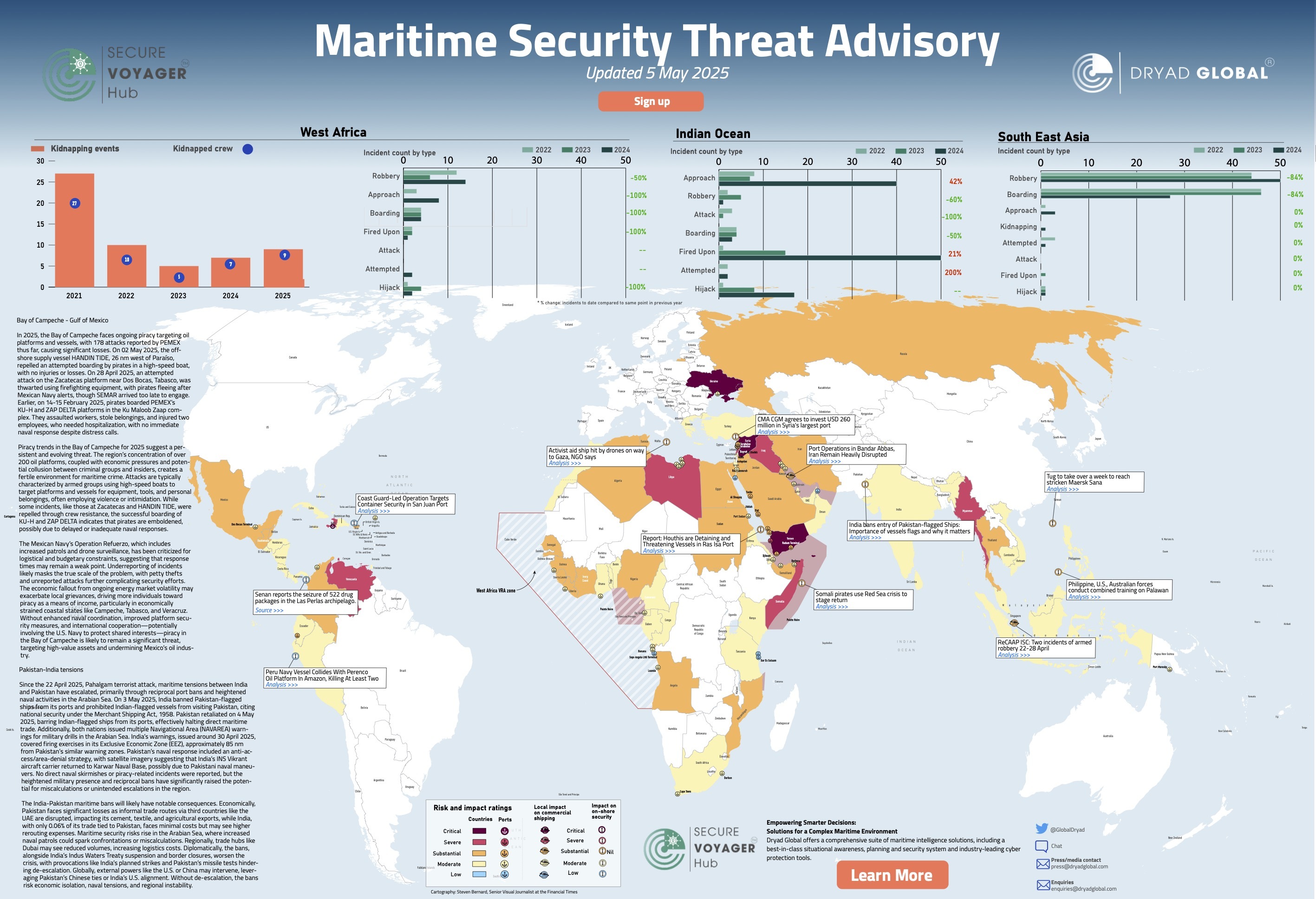This week’s maritime security landscape highlights intensifying piracy risks in the Gulf of Mexico, escalating naval tensions between India and Pakistan, and wider geopolitical shifts affecting maritime operations across key chokepoints and shipping lanes.
Piracy Persists in the Bay of Campeche
Maritime crime continues to plague Mexico’s oil-rich Bay of Campeche, with offshore platforms and support vessels facing increasing threats. On 2 May, the offshore supply vessel HANDIN TIDE successfully repelled a pirate boarding attempt 26 nautical miles west of Paraíso. Just days earlier, an attack on the Zacatecas platform near Dos Bocas was thwarted by crew using firefighting equipment, although the Mexican Navy arrived too late to intervene.
The year has already seen 178 attacks reported by PEMEX, and the violent boarding of the KU-H and ZAP DELTA platforms in February underscores how emboldened these criminal groups have become. Armed gangs, often using high-speed boats, are targeting assets for equipment and personal belongings, exploiting gaps in naval response and alleged insider collusion.
Key Factors:
-
Underreported incidents mask the true scale of piracy.
-
Mexico’s naval operation, Refuerzo, faces logistical and funding constraints.
-
Socioeconomic pressures in coastal states like Campeche and Tabasco are fuelling recruitment into piracy.
Without coordinated international support and a ramp-up in platform security, these attacks are likely to persist—posing risks not only to local operators but to global energy markets.
Maritime Fallout from India–Pakistan Tensions
The fallout from the 22 April Pahalgam terrorist attack has spilled into the maritime domain, with both India and Pakistan enacting reciprocal port bans. As of 3 May, India has barred Pakistan-flagged vessels from its ports under national security provisions. Pakistan followed suit the next day.
This effectively freezes direct maritime trade between the two countries. Naval drills by both sides in the Arabian Sea, along with increased deployments, have raised the spectre of accidental escalation.
Implications:
-
Trade disruptions are likely to hit Pakistan’s export sectors hardest, particularly cement, textiles, and agriculture.
-
Dubai and other regional hubs may experience spillover effects as rerouted cargo increases logistical strain.
-
India faces minor trade impacts, but strategic risks remain high due to growing naval assertiveness on both sides.
With no sign of diplomatic thaw and continued provocations—like missile tests and suspended water-sharing treaties—maritime friction remains a potent flashpoint for broader instability in South Asia.
Global Incident Highlights
-
Red Sea: Somali pirate groups appear to be capitalising on regional instability to reassert themselves in the area.
-
San Juan Port, Puerto Rico: Authorities have stepped up container inspections as part of a wider security operation.
-
Amazon Region, Peru: A tragic collision between a naval vessel and an oil platform has claimed at least two lives.
-
Ras Isa Port, Yemen: Reports suggest Houthis are detaining and threatening vessels.
-
Bandar Abbas, Iran: Ongoing disruptions are hampering port operations amid broader geopolitical tensions.
-
Syria: CMA CGM’s planned $260M investment in Tartus port signals growing commercial interest in high-risk environments.
Regional Risk Overview
Across Southeast Asia, the Indian Ocean, and West Africa, Dryad Global continues to monitor incidents ranging from armed robbery and attempted hijackings to crew kidnappings. While overall figures fluctuate, the data reveals persistent and evolving threats that demand robust maritime domain awareness and responsive planning.
Dryad Global remains committed to empowering maritime operators with the intelligence and tools required to make informed decisions in a complex and dynamic threat environment.





